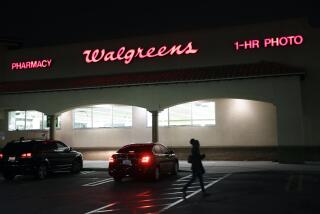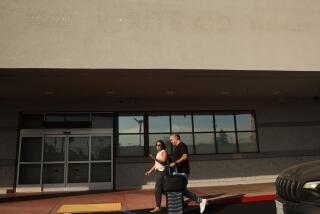Wells Fargo, Drugstore to Share Space
Wells Fargo is hoping to take care of your financial headaches and your Excedrin headaches . . . under one roof.
In a first for a bank, Wells announced Tuesday that it will share space with Thrifty PayLess drugstores, converting a handful of branches into bank-and-buy centers that will process prescriptions as well as paychecks.
A pharmacist will be on hand along with the usual lineup of tellers in at least five Wells Fargo branches by early next year. Bank customers will be able to drop off film for developing or pick up greeting cards and other drugstore goods.
The locations have not been selected, but three or four will be in Southern California, the companies said.
If the pilot program is successful, as many as 50 other branches in the 11 Western states served by Wells Fargo will be converted, the companies said at news conferences in Los Angeles and San Francisco.
âWe plan to test this concept and then roll it out aggressively,â said Jim Ketcham, executive vice president in charge of strategic planning at Wells Fargo.
The deal is the latest enabling widely differing companies to share space, costs and access to customers.
Not long ago, banks joined the independent florists and cleaners who have set up shop in supermarkets. Blockbuster, the video rental giant, now operates kiosks at grocery stores.
The greatest growth in these crossbreeding partnerships has involved restaurant chains. Little Caesarâs serves pizza at Kmart. McDonaldâs is in Wal-Mart. Pizza Hut has stores in hotels. And fast-food chains operate at gasoline service stations.
âThese deals work best if both companies are well known,â said Sid Doolittle, partner at McMillan/Doolittle, a Chicago-based consumer research firm. âTwo well-known companies will attract more trusting consumers than one well-known business.â
Besides helping Wells Fargo reach drugstore shoppers who now bank elsewhere, the experiment shows how far banks will go to offset the huge costs of renting and maintaining hundreds of branches.
Many U.S. banks are saddled with far more branches than they need, left over from networks built long before droves of customers began shunning a trip to the teller for banking by telephone or automatic bank machine.
Closing a branch outright is not easy, since such a move requires regulatorsâ approval.
Leasing space inside a branch also allows Wells to avoid the trouble of searching for a new, smaller space to serve the same area and building a more efficient office from scratch.
âWe have great branch locations, and we donât need the space,â said Jim Ketcham, head of strategic planning at Wells.
The oversupply of costly branches helped fuel a recent wave of big bank mergers, allowing rival banks to cut costs by shutting duplicate offices. Wells Fargoâs $13-billion acquisition in April of California rival First Interstate Bancorp--the biggest bank merger ever--was designed to allow Wells to slash costs by closing almost 300 branches.
Under the agreement announced Tuesday, San Francisco-based Wells will lease space at selected branches to Thrifty PayLess. The drugstore company, headquartered in Oregon, will also share the cost of converting the branches.
Thrifty PayLess will occupy most of the space at the converted sites, but at least 2,000 to 3,000 square feet will be set aside for full-service banking.
Analysts expect the novel arrangement to attract the interest of consumers.
âConvenience is driving this,â said Cynthia Cohen Turk, head of Marketplace 2000, a retail consulting firm with offices in New York and Miami. âIncreasingly, consumers need to get things done in a short period. These arrangements save time.â
That is especially true for drugstore customers, said Richard Nelson, a retail analyst at Nesbitt Burns Securities Inc. in Chicago.
âConvenience is even more important than price,â Nelson said. âWhen youâre sick, you want to get a prescription as soon as possible.â
Bloomberg Business News contributed to this report.
More to Read
Inside the business of entertainment
The Wide Shot brings you news, analysis and insights on everything from streaming wars to production â and what it all means for the future.
You may occasionally receive promotional content from the Los Angeles Times.










